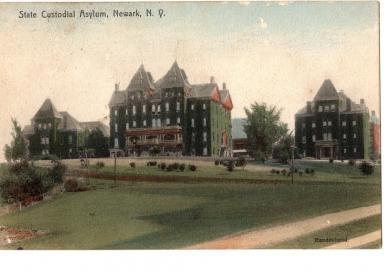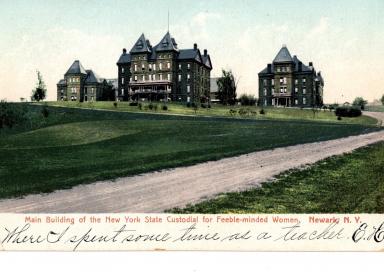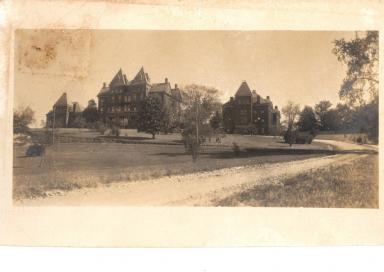If you find errors OR have additional information about this site, please send a message to contact@waynehistorians.org.
Newark Developmental Center. Newark State School. NYS Custodial Asylum.
| Historic Site #: | 01-149 (Exists) Type: E3,K3,K4 | Town: | Arcadia | ||
| Site Name: | Newark Developmental Center. Newark State School. NYS Custodial Asylum. | GPS Coordinates: | 43.0420911785806, -77.0827641656187 | ||
| Address: | East Maple Avenue | ||||
| Description: | |||||
| Historic narrative: | |||||
Town Historian Traces History of State School Buildings By Cecilia B. Jackson (Arcadia Town Historian) Newark Courier-Gazette, Thursday, September 13, 1973 “Commandingly situated upon the summit of a large hill at East Newark is a fine brick edifice, which is seen for miles away, and attracts the attention of tourist and stranger.” This is quoted from McIntosh’s History of Wayne County covering the period from 1789 to 1877. The statement of course refers to the buildings, about to be demolished, at the north end of the Newark State School. McIntosch continues “Its early history is involved in obscurity. A site of 4 ½ acres was purchased, and the erection of the building was begun by Henry Price.” (Roderick Price) “Subscriptions were slow of collection and the work was left unfinished till the property was purchased by the German Lutherans, by whom it was completed, furnished and on September 3, 1873, opened as a collegiate institute with Rev. Manz as president and Prof. Giese as principal.” “There were 36 students in attendance. The property was sold on June 26, 1876, to George Wagner of Rochester and at present (1877) remains unoccupied. It is contemplated to make a sale to the Missouri Synod of the German Lutheran Church by whom and academy will be established. The structure is one that does credit to the place and has the appliances for successful education.” True, it was an ideal spot for a college and twice efforts were made to establish one there. Various authorities differ on details, but in 1902 Imogene Russell wrote in her Old Time Days of Newark, “The most prominent man in Lockville in its early and prosperous days, a man enthusiastic in its interest, and who bent all his energies toward making it the business center of the town was Roderick Price.” (Roderick Price was an ancestor of Charles Underhill, librarian here from 1958 to 1965). “Mr. Price”, Miss Russell continues, “built a flour mill, bought grain and had a store in the same building with his warehouse.” “Although his large business claimed much of his time, he took an active part in public enterprises, and when the plan of establishing a Baptist College on the hill now occupied by the Custodial Asylum was proposed, Mr. Price gave four acres of land for the site. He afterwards put many thousand dollars into the work, which finally resulted in failure, his heirs receiving only a small return for the large amount he had expended.” The Baptist Society had been organized in 1835 and the fine old structure in brick, still standing on Church Street, East Newark, was erected by them in 1836-37, land having been purchased from James Snow on Aug. 15, 1836. The old church is now a two-family house. The movement to establish a Baptist College so nearby was apparently the outgrowth of this active church, and buildings were started long before the Civil War. This is confirmed by an Early History of Newark written by Miss Lizzie West in 1918, which states, “Just before the rebellion a brick building was commenced on Asylum Hill intended for a Baptist Collegiate Institute. Funds failed, work was suspended, and 12 years later was purchased by and finished for a Lutheran Academy. It was used from 1873-1876 as a college but want of students and funds caused foreclosure of mortgage and it remained idle until the state became interested in the property.” Landmarks of Wayne County, written in the 1890s credits S.S. Peirson and E. K. Burnham with untiring efforts to have a bill passed in the State Legislature incorporating and permanently establishing the school, which had been an experimental branch of the Syracuse Asylum since 1878 when it started with nine girls. The bill was passed on May 14, 1885, and Mr. and Mrs. C. C. Warner served as first superintendent and matron. They resigned in 1886 and MR. and Mrs. W. Landon Willett were employed, who were in turn replaced by Mr. and Mrs. W. W. Winspear in 1893.” Robert Hoeltzel, local historian, provided the material from Lizzie West as well as other items of interest telling of the improvements to the three buildings at the north end of the property. The driveways in front of the asylum were installed in 1887, he revealed. The corridors connecting the buildings were built in 1887. The main building at that time measured 60 x 120 feet. The standpipe was built in 1889 and the hospital (old) built in 1916. The porch on the main building was added in 1893. Mr. Hoeltzel added that Detrich Ehrhardt II, a distant relative of his mother’s, attended the Lutheran Academy in the early 1870s. An old clipping states that on a “clear, bright day in June (in 1893) people from surrounding communities began coming up the hill for the formal dedication to which the public had been invited. The newly completed chapel was filled to its 600-seat capacity and the New York State Custodial Asylum for the Feebleminded Women became a reality.” With the establishment of the Department of Mental Hygiene of the State, the institution became known as the Newark State School in 1927. These three long-time landmarks are to be demolished because they are old and fire hazards! Yes, in the early thirties, there was a fire in the west building, but it was promptly controlled, and no one was hurt. Sprinkler systems are now throughout the buildings. So many of our landmarks have been destroyed, as the O.H. Allerton mansion (which became the Elks Club) because they were fire hazards. To any historian the question arises, IF they are fire hazards, how does it happen they have stood for well over 100 years when many far newer buildings have been leveled by fire. Demolition is scheduled for these landmarks, first a Baptist College, then a Lutheran Collegiate Institute, then Newark State School. We wonder if the new administration building on East Maple Avenue will ever be considered a landmark? | |||||



